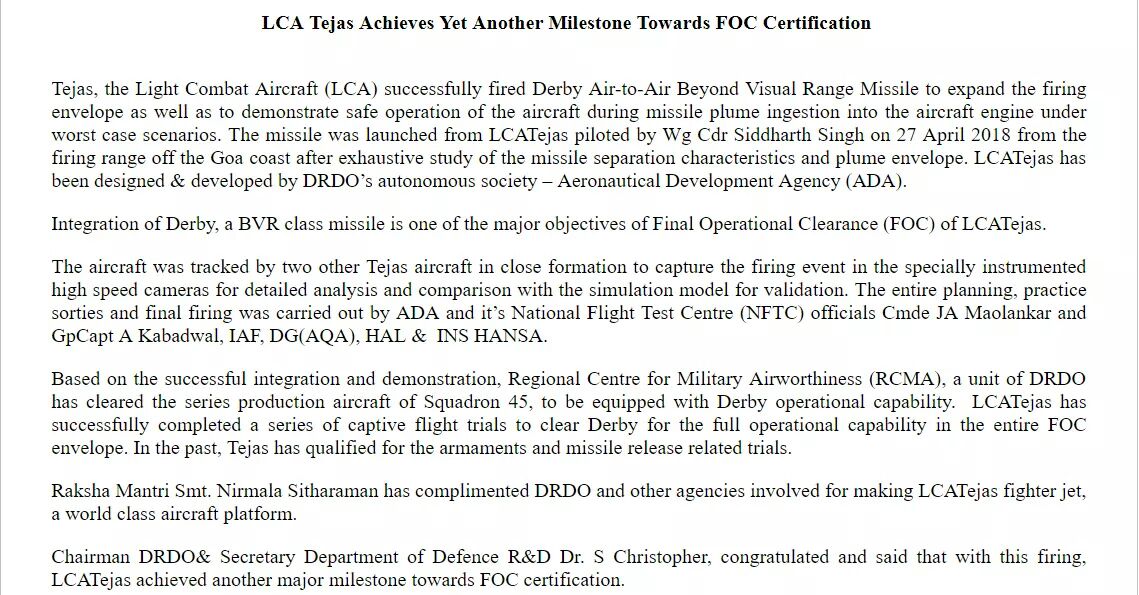LCA AF MK2
***************
The MK2 is an improvement over LCA AF Mk1
with higher thrust engine. This aircraft will
have improved survivability, maintainability
and obsolescence mitigation. Active
Electronically Scanned Array (AESA) Radar,
Unified Electronic warfare Suite (UEWS) and
On-Board Oxygen Generation System
(OBOGS) are some of the state of the art
technologies planned to be integrated. The
cockpit design has been improved with
bigger size, smart Multi function Displays
(MFD) and smart Head Up Display (HUD).
The scope of FSED Phase 3 as per project
sanction is as follows:-
Design, develop and build two aircraft with
New Engine
Necessary changes in the structure and
systems to integrate the new engine
Weight reduction to improve performance
Unified EW Suite (UEWS)
Development of new DFCC, its test facilities
and integration
Upgrade/modification/maintenance of test
facilities.
Extensive studies were carried out at ADA to
make suitable changes in LCA AF Mk2 to
address the maintainability issues observed
in LCA AF Mk1, improve the systems like fuel,
landing gear and brakes, electrical,
armament etc. Also a number of new/
upgraded systems have been incorporated
to make the aircraft more contemporary. As
a result, the scope for FSED Phase 3
increased substantially due to extensive
changes incorporated to have an improved
aircraft with improved performance in all
aspects. Important new/ upgrades of
systems are listed below:
Introduction of 500mm plug in fuselage
Active Electronically Scanned Array (AESA)
radar
On Board Oxygen Generation System
(OBOGS)
New Cockpit with larger size smart displays
One Mission Management and Display
Computer (MMDC) in place of two Open
Architecture Computers
HMDS based on optical sensor
Smart HUD with improved Field of Vision
Higher power Jet Fuel Starter
Servo controlled Airbrake under the
command of DFCC control
Pressurized Fuel System
Unified Pylon Interface Computer (UPIC) in
place of individual Pylon Interface Boxes
Combined Interrogator Transponder (CIT)
Indigenous Actuators
NVG(Night vision Goggle) compatible
lighting
Activities carried out
Presently, the configuration of LCA AF Mk2
has been frozen with all the design
improvements and Preliminary Design
Review (PDR) has been carried out in June
2014 and detail design is in progress. GE-
F414 engine was selected as the higher
thrust engine for LCA AF Mk2 and a contract
was signed with M/s GE, USA in September
2012. The CDR of alternate engine has been
completed. Engine is undergoing final
qualification and lifting evaluation tests.
Aerodynamics
******************
A number of aerodynamics improvements
have been carried out to reduce drag and
improve performance:
Drag reduction studies have been
completed. Canopy reshaping, outer cowl
modification, actuator fairing extension and
supersonic pylons have resulted in approx
20 counts (8%) drag reduction in
supersonic regimes.
Wind Tunnel studies have been completed.
Aero loads computations have been
completed
Airframe
***********
Three doors AAID finalized.
BMI material developed for high
temperature applications.
Composite pipelines developed for ECS.
Spine widened for providing accessibility
and maintainability.
Pilot step provided for pilot's emergency
egress.
SPS bay redesigned to improve
maintainability.
Engine
*********
Aircraft engine bay ventilation scheme has
been finalised.
Engine-Airframe Interface Control Diagram
(ICD) has been prepared.
Aircraft Qualification Tests have been
completed. ASMET (Air c r a ft Simulated
Mission Endurance Tests) results are under
discussion.
New JFS with higher torque GTSU- 135 is
under development.
Mechanical Systems
**************************
Layouts preparation and detail design is in
progress.
Feasibility to increase wheel size for
increasing the capacity of brake system are
in progress.
Trials to offload one hydraulic system to
reduce the load on JFS during starting are
going on. This will help in cold weather high
altitude operations.
Liquid Cooling System configurations,
separate for AESA and UEWS have been
finalised.
Studies to shift the Air to Air refueling probe
to right are in progress to obviate probe
coming in Field of View of Head Up Display
(HUD).
Integrated Flight Control System
******************************
***********
DFCC: CDR completed Realization st of QT unit
by 31 Dec 2016.
Indigenous Actuators: Primary Actuators QT
completed, Iron Bird testing completed.
Being evaluated on LCA Mk1. Secondary
Actuators under development.
Avionics
Avionics architecture has been finalized.
New cockpit with bigger size (6”x8”)
displays has been designed.
Development of new LRUs is in progress.
Avionics will be ready by Dec 2018.
Configuration of Active Phased Array based
Unified Electronic Warfare Suite (UEWS)
finalised.
The number of elements that can be
incorporated with the existing geometry for
the Antenna Array unit of AESA Radar has
been finalised and performance parameters
like range and Effective Radiated Power
(ERP) computed.
Night Vision Goggl e (NVG) compatible L E D
lights for Navigation lights and Taxi /
Landing Lights are being developed.
Engineering models have been developed.
Performance is being evaluated.
Conformal antenna developed for V/UHF.
Under development Technologies for LCA
******************************
***********************
Development of critical advanced
technologies for indigenous equipments
and systems is in progress. Project sanctions
for development of technologies have been
given to identified work centers. The
following project s has been completed;
DALIA actuators
Indigenous development of high strength
titanium alloy Ti-10
Development of Friction Stir Waelding
Technology for Aircraft Structures
Aerodynamic studies of performance of LCA
wing with Vortex Generators
LCF data generation testing on 15-5 PH steel
Digital Communication Scheme for Tejas
On-going Projects
***********************
The following major projects have been
initiated and are in progress
Development of V/UHF Conformal Antenna
Development of Digital Audio Control System
(DACS)
Digital Liquid Oxygen (LOX) Indicators/
Transmitters
Development of improved RAM
Fatigue data generation on AA 7010
Aluminium alloy
Development of Zn-Ni plating as an alternate
to cadmium plating
Development of high temperature beta
titanium alloy DMR 700
Development of On-Board Oxygen
Generation System (OBOGS)
Development of Cabin Shut Off Valve (CBSOV)
of ECS,
Development of AMAGB Bearings
Advanced Subminiature Telemetry System,
Jet Fuel Starter (JFS) Mark 2
Development of MEMS based Pressure
Transducers and temperature sensors for
Hydraulics system.
Credits.Next Generation weapons Technology
https://www.facebook.com/Defence360/posts/1765155550443188:0





